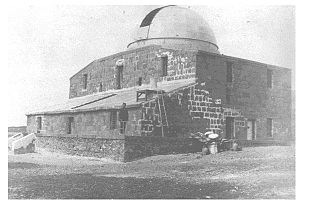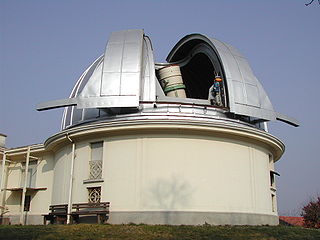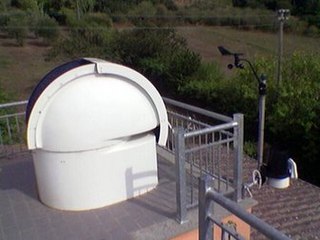 W
WThe Arcetri Observatory is an astrophysical observatory located in the hilly area of Arcetri on the outskirts of Florence, Italy. It is located close to Villa Il Gioiello, the residence of Galileo Galilei from 1631 to 1642. Observatory staff carry out theoretical and observational astronomy as well as designing and constructing astronomical instrumentation. The observatory has been heavily involved with the following instrumentation projects:The MMT 6.5 m telescope The LBT 2x 8.4 m telescopes The Telescopio Nazionale Galileo 3.5 m telescope The VLT telescope adaptive secondary mirror The 1.5 m Gornergrat Infrared Telescope (TIRGO)
 W
WThe Asiago Astrophysical Observatory is an Italian astronomical observatory owned and operated by the University of Padua. Founded in 1942, it is located on the plateau of Asiago, 90 kilometers northwest of Padua, near the town of Asiago. Its main instrument is the 1.22-meter Galilei telescope, currently used only for spectrometric observations.
 W
WThe Cima Ekar Observing Station is an astronomical observatory on the crest of Cima Ekar, a mountain ridge located approximately 4 kilometers southeast of and 350 m higher than the town of Asiago, Italy.
 W
WAURIGA is an ultracryogenic resonant bar gravitational wave detector in Italy. It is at the Laboratori Nazionali di Legnaro of the Istituto Nazionale di Fisica Nucleare, near Padova. It is being used for research into gravitational waves and quantum gravity.
 W
WBassano Bresciano is a comune in the province of Brescia, in Lombardy. As of 2011 Bassano Bresciano had a population of 2,237.
 W
WThe Brera Observatory is an astronomical observatory in the Brera district of Milan, Italy. It was built in the historic Palazzo Brera in 1764 by the Jesuit astronomer Roger Boscovich. Following the suppression of the Jesuits by Clement XIV on 21 July 1773, the palace and the observatory passed to the then rulers of northern Italy, the Austrian Habsburg dynasty. Following the independence of Italy in 1861, the observatory has been run by the Italian government.
 W
WThe Cagliari Observatory is an astronomical observatory owned and operated by Italy's Istituto Nazionale di Astrofisica. It is located 20 km away from Cagliari in Sardinia. It was founded in 1899 to study the Earth's rotation.
 W
WThe CINEOS program, started in 2001, is dedicated to the discovery and follow-up of near-Earth objects (NEOs), namely asteroids and comets which periodically approach or intersect the Earth's orbit. In particular CINEOS is addressed to the discovery of Atens and Interior-Earth Objects (IEOs) by extending survey coverage at small solar elongations, and to the discovery of the other kind of NEOs by observing with longer exposures in the opposition region.
 W
WThe Astronomical Observatory of Capodimonte is the Neapolitan department of Istituto Nazionale di Astrofisica, the most important Italian institution promoting, developing and conducting scientific research in the fields of astronomy, astrophysics, and space science.
 W
WThe Catania Observatory is an astronomical observatory in the city of Catania, on the island of Sicily in southern Italy. It is operated by INAF, the National Institute for Astrophysics.
 W
WThe Collurania Observatory, also Teramo Observatory,, is an astronomical observatory located in Teramo, in Abruzzo region of central Italy. It was founded by Vincenzo Cerulli in 1890, who was later honoured by having it bear his name. The observatory is owned and operated by the National Institute for Astrophysics (INAF). It has the IAU code 037.
 W
WThe European Gravitational Observatory or EGO is located in the countryside near Pisa, in the hamlet of Santo Stefano a Macerata in the comune of Cascina. In order to ensure the long term scientific exploitation of the Virgo interferometric antenna for gravitational waves detection as well as to foster European collaboration in this upcoming field, the Virgo funding institutions have created a consortium called EGO.
 W
WThe Helmut Ullrich Astronomical Observatory is an observatory situated on Col Drusciè, a mountain peak in the Dolomites located within Cortina d'Ampezzo, Italy. The observatory sits at an elevation of 1,780 metres (5,840 ft) above sea level and includes two domes, with a 20" Newtonian telescope and an 11" Schmidt–Cassegrain telescope inside.
 W
WThe International Latitude Observatories were a system of (originally) six observatories located near the parallel of 39° 08' north latitude. They were used to measure the variation in latitude that occurs as a result of the "wobble" of the Earth on its polar axis.
 W
WThe Medicina Radio Observatory is an astronomical observatory located 30 km from Bologna, Italy. It is operated by the Institute for Radio Astronomy of the National Institute for Astrophysics (INAF) of the government of Italy.
 W
WMerate Astronomical Observatory is an old observatory in Merate (Lecco), Italy. It has housed a 1-meter Zeiss telescope since 1926.
 W
WThe Monte Mario Observatory is an astronomical observatory and is part of the Rome Observatory. It is located atop of Monte Mario in Rome, Italy. This location was used as the prime meridian for maps of Italy until the 1960s.
 W
WThe Noto VLBI Station is a radio observatory located on Sicily, southern Italy, outside the city of Noto. The facility is operated by the Istituto di Radioastronomia di Bologna.
 W
WOriolo Romano Observatory is an amateur astronomical observatory in Oriolo Romano, Viterbo, Italy. Built in 2007, the observatory has a Celestron 8" Schmidt-Cassegrain F/10 telescope. The observatory was designed to be fully robotic, uses a QSI WS40 CCD camera with clear filter for data acquisition. The observatory is only used for astronomical research and educational outreach.Website contains a guide to Universities in the United States and in Italy specialized in Physics. Astrophysics and Astronomy. In addition to the "orioloromano observatory" being an astronomical observatory, it also functions as a local weather station with webcam always on line. The weather station's main purpose is to provide data for planning observing sessions by gathering information about the condition inside and outside the observatory. Conditions at the observatory are monitored and logged by a weather station. The station provides indoor and outdoor temperature as well as barometric pressure, humidity, rainfall, wind speed, direction and dew point. The data is reported real time, as well as logged. The station is configured to log and upload data to this website in 15-minute intervals. This data is also made available to forecasters, pilots, ships or anyone who needs it.
 W
WThe Osservatorio Ximeniano is an independent measurement and research specialist in meteorology and geophysics. It is based in Florence. It is named after Leonardo Ximenes.
 W
WThe Giuseppe S. Vaiana Astronomical Observatory is an astronomical observatory located in Palermo, Sicily, Italy, housed inside the Palazzo dei Normanni. It is one of the research facilities of the National Institute of Astrophysics. The observatory carries out research projects in the field of astronomy and astrophysics including the study of solar and stellar coronas, stellar evolution and of the supernova remnants.
 W
WThe Panzano Observatory was an observatory in the village of Panzano about 3 kilometres to the NNW of the centre of the comune of Castelfranco Emilia, near Bologna, Italy, where Giovanni Cassini worked. It was built in the early 1640s by Cornelio Malvasia.
 W
WThe Pistoia Mountains Astronomical Observatory, also known as the San Marcello Observatory and the Pian dei Termini Observatory, is an astronomical observatory in San Marcello Piteglio, Tuscany, central Italy.
 W
WThe Astrononomical Observatory of Rome is one of twelve Astronomical Observatories in Italy. The main site of the Observatory is Monte Porzio Catone. Part of the Istituto Nazionale di Astrofisica since 2002.
 W
WThe San Vittore Observatory is an astronomical observatory in Bologna, Italy. It has made numerous asteroid discoveries during 1980–2000.
 W
WThe Sormano Astronomical Observatory is an astronomical observatory north of Milan, Italy. Located near the Swiss border at 1000 meters altitude at the mountain village of Sormano in the pre-Alps, the observatory was privately funded by the Gruppo Astrofili Brianza and built in 1986.
 W
WLa Specola is a 14th-century tower, formerly part of a medieval castle, and converted in 1767 into an astronomical observatory (specula) in Padua, region of Veneto, Italy.
 W
WThe Observatory of Turin is an astronomical observatory owned and operated by Italy's National Institute for Astrophysics. It is located on the top of a hill in the town of Pino Torinese near Turin, in the north Italian Piedmont region. The observatory was founded in 1759. At Pino Torinese, several asteroid discoveries were made by Italian astronomer Luigi Volta in the late 1920s and early 1930s. The asteroid 2694 Pino Torinese was named after the observatory's location.
 W
WAstronomical Observatory of Trieste is an astronomical center of studies located in the city of Trieste in northern Italy.
 W
WThe Vatican Observatory is an astronomical research and educational institution supported by the Holy See. Originally based in the Roman College of Rome, the Observatory is now headquartered in Castel Gandolfo, Italy and operates a telescope at the Mount Graham International Observatory in the United States.
 W
WThe Virgo interferometer is a large interferometer designed to detect gravitational waves predicted by the general theory of relativity. Virgo is a Michelson interferometer that is isolated from external disturbances: its mirrors and instrumentation are suspended and its laser beam operates in a vacuum. The instrument's two arms are three kilometres long and located in Santo Stefano a Macerata, near the city of Pisa, Italy.